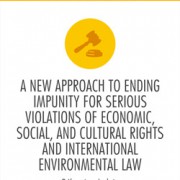Recognising nature as a legal person: the Whanganui River in New Zealand
The relationship between indigenous peoples and nation states is historically marked by conflict and oppression. The exploitation of natural resources, usually ignoring indigenous knowledge, feed into these conflicts,threatening the sovereignty, rights, culture and ultimate existence of indigenous peoples. The historical relationship between the state of New Zealand and the Māori has proved to be no exception. However, the 2014 Whanganui River Deed of Settlement is an exemplary attempt to protect the River, and its natural resources while respecting incorporating the long ignored voices of the local Whanganui tribes.
Conflict flows
The Whanganui River, home for a large proportion of Māori villages in pre-European times and regarded as taonga (special treasure), is sacred to the Whanganui Iwi Māori tribe and believed to have human traits. Prior to 1848 a substantial Māori population, which was dispersed along the Whanganui River and its major tributaries, enjoyed rights and responsibilities over it. This changed in 1848 when the Crown purchased 86,200 acres of land at Whanganui. The Crown proceeded to assert authority over the land and River within the area purchased and, as a result, faced Māori opposition, who asserted control over the rest of the area and continued to make use of the River.
Frequent conflicts arose between the Crown and the Māori. The River’s relevance as an important communication route motivated, in 1887, the inauguration of a steam-boat service, which was protested by the locals, who argued this would greatly affect fish and eel weirs population, their main food source. Only a few years later, by 1891 most fish and eel weirs had, in fact, been destroyed, and yet the boat services continued. Rights to extract and sell gravel from the River were equally protested by the Whanganui Iwi, who attempted to obstruct the River works, but were ignored by the Parliament. In 1903, the Coal-mines Act Amendment Act, without consultation with the Whanaganui Iwi, brought further misery, by declaring the beds of all navigable rivers to be vested in the Crown.
The Māori tribe continued to be voiceless throughout the 20th Century until the Whanganui River Māori Trust Board was established. It negotiated outstanding Whanganui Iwi claims for the settlement over the Whanganui River and, in signing the Deed of Settlement, the Crown recognised, amongst other things, “its failure to protect the interests of Whanganui Iwi, and the adverse effects and prejudice caused to Whanganui Iwi.”
Several settlements have, prior to the Whanganui River Deed of Settlement, recognised Māori conceptions of the environment, among them are settlements that relate to the Waikato, Waipā and Kaituna Rivers. The Waikato River settlement, for example, recognises that the River is an ancestor (tupuna) to the Waikato-Tainui and it possesses a life force.
The Settlement
On August 2014, and following numerous petitions to Parliament dating back more than a century, the Whanganui River Deed of Settlement (or Ruruku Whakatupua) was finally signed. Under the settlement, the Whanganui River is recognised as a legal person, granting the River rights, powers, duties and liabilities and “recognises the intrinsic ties which bind the Whanganui River to the people and the people to the Whanganui River.” Not only has Māori belief been incorporated into the Deed of Settlement but the River is also represented by two guardians (with advisors) who act ‘as one’: one is nominated by the Crown and the other one by the Iwi natives.
The Deed of Settlement helps ensure a more sustainable usage of natural resources by, for example, significantly limiting dredging from the riverbed. It also respects natural areas and traditional knowledge: S.3.3.3. states that Iwi and Crown guardians, working must “promote and protect the health and well-being” of the River within a framework of traditional Māori knowledge. Ensuring a less polluted River, not only helps to restore local ecosystems and balanced biodiversity, but it brings a significant impact on the ocean’s health as well.
This policy is not only vital for environmental and natural resources protection but it also recognises the local community and its relationship with the State, and the local environment. Poverty and human rights violations are addressed through the redress of historic exploitation by the Crown and the development of the River that had taken place without Māori consent. The Crown also “recognises its failure to protect the interests of Whanganui Iwi, and the adverse effects and prejudice caused to Whanganui Iwi.” The historical oppression by the Crown over the Iwi is also taken into account. By consulting and partnering with local tribes, the Crown provides an avenue to redress such atrocities and violations, where possible.
It must be noted, however, that this Settlement is only appropriate and well-adapted to the cultural values and traditions of the Iwi. Local inhabitants of other faiths don’t have their beliefs acknowledged within the Deed of Settlement. This means that the Deed does not have the neutrality of pluralism and secularism, which the New Zealand government displays elsewhere in its policies.
By electing guardians and advisors from the tribe and incorporating their beliefs, knowledge and practices, it further empowers the local Iwi. It also provides for public consultation and genuine engagement in its design and implementation such as the appointment of legal representatives who “must … develop appropriate mechanisms for engaging with and reporting to [local Māori] on matters relating to [the river]”. The Deed establishes a strategy group comprised of representatives of persons and organisations with interests in the Whanganui River. This includes the Iwi, local and central government, commercial as well as recreational users and environmental groups.
This Settlement is by no means the consequence of a fully healed relationship, both between New Zealand’s indigenous peoples and the State, and between humans and nature. However it is a cause for celebration. The burden of environmental degradation rests the heaviest on the shoulders of indigenous peoples, who are more likely to rely upon a healthy and thriving environment and yet, perversely usually have little say, or few means of access in these matters. Hopefully policies like the Whanganui River Deed of Settlement can inspire Governments around the world to take action towards recognising and respecting indigenous knowledge, and the restorative capacity of healing nature and communities.












